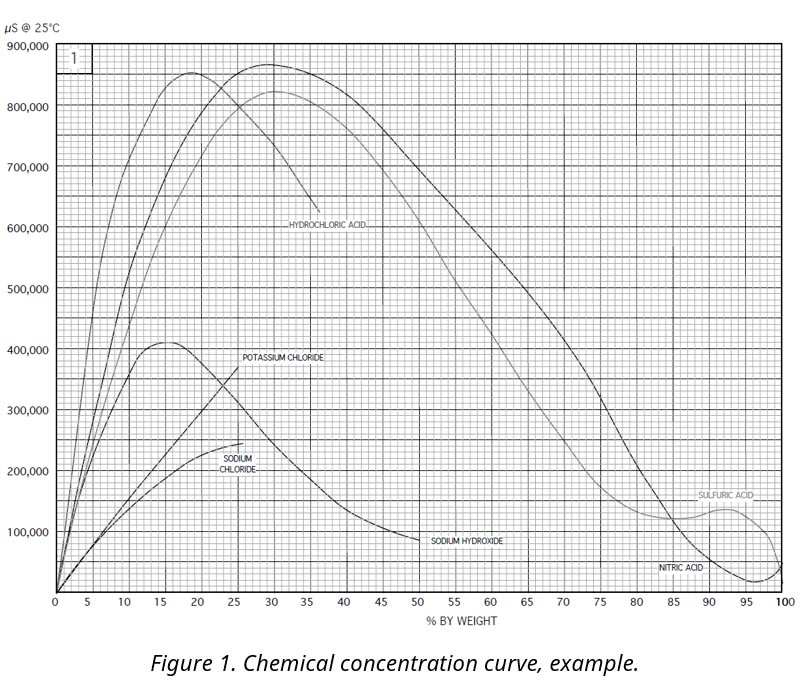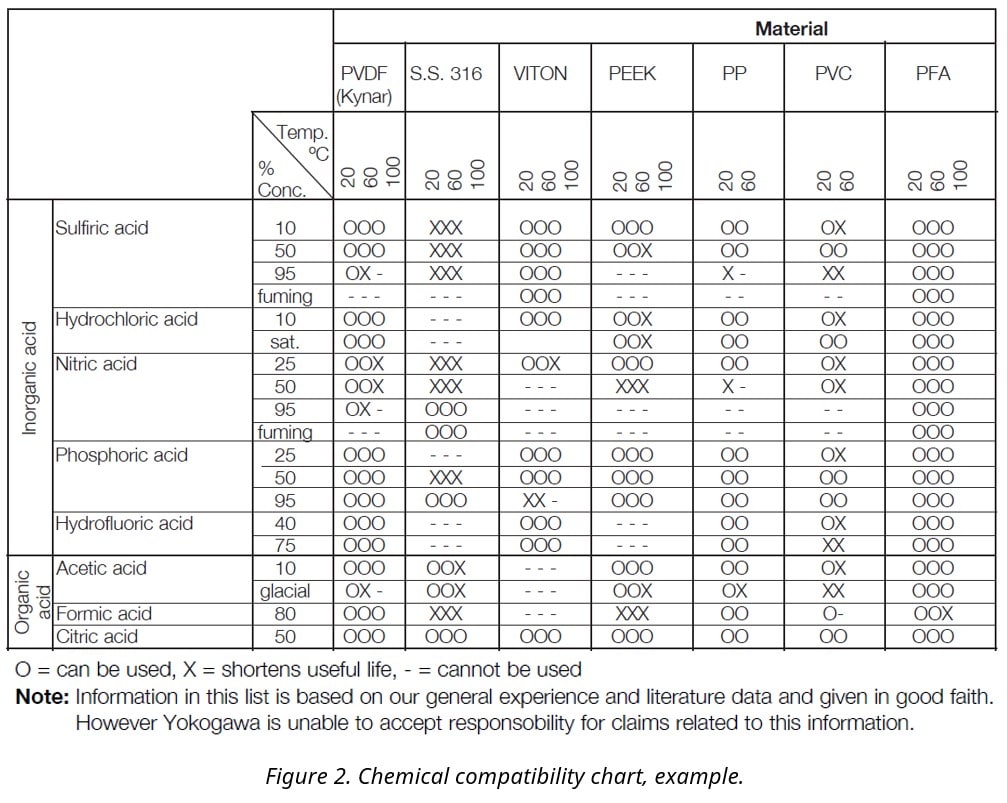Application
There are numerous industrial applications where measurements and/or control of a specific chemical strength of the process is critical for optimizing the production of the end product. These specific concentrations are obtained by mixing a full-strength solution with water to achieve the desired percent concentration.
Process
The desired chemical concentration is achieved using a two-stage mixing procedure. During the first stage, the flow ratio control unit on the missing tank is set to provide (x) gallon per minute of the full-strength solution and (y) gallons per minute of water. These values are adjusted to produce a concentration value that is slightly weaker than the desired value. This ratio control must include alarm capabilities to indicate "low flow" conditions for both the full strength solution and the water in order to prevent wasted chemicals or hazardous situations.
At the second stage, a conductivity sensor and analyzer function as a "trim control". This combination adds small amounts of full-strength solution to the mixing tank to produce the exact concentration desired.
For example, to produce a 4% caustic solution from a large bulk caustic supply at 50%, the flow ratio controller is adjusted to make a 3% solution and the conductivity information is used to add additional caustic to achieve the 4% concentration.
Conductivity is a very reliable index of the concentration for most acid and base (caustic) solutions. Figure 1 shows the correlation between conductivity and concentration for four common solutions.
Challenges
For most solutions, there is a peak conductivity value. Before this peak value is reached, conductivity correlates positively with concentration; after the peak, it correlates negatively. So, if the concentration range passes through the peak for that chemical the conductivity value (except the peak value) represents two different concentration values. Therefore, it is mandatory that any application near the peak of a particular solution be carefully controlled.
Solution
Conductivity measurement is a reliable indicator of the concentration of most acid or base solutions. In determining the proper loop components for a particular application, the material of construction will be of primary concern. A chemical resistance chart should be consulted (see Table 1), or an application data sheet completed and sent to the factory in order to insure an installation that will be suited for the intended application.
Key Advantage & Recommendations
One sensor that will measure the entire conductivity range. Since the sensor is non-contacting it is not affected by chemical attack and requires less overall maintenance.
Conductivity Measurement Systems
Process Liquid Analyzer:
• 2-wire FLEXA Inductive Conductivity Analyzer
• 4-wire FLXA402 Inductive Conductivity Analyzer
Sensor Selection:
ISC40G General Purpose Sensor
ISC40S Intrinsically Safe Sensor
• Available in PEEK and PFA material for more aggressive chemicals
Note: For additional information or assistance on this application, please contact the Yokogawa Analytical Product Marketing.
Industries
-
Floating Production Storage & Offloading (FPSO)
- Floating Production, Storage, and Offloading (FPSO) unit
- Offshore production facility
- Stores processing equipment, produced hydrocarbons storage
- Feasible to produce oil in remote areas, deeper water
-
Food & Beverage
The food and beverage industry must produce safe, high-quality foods and beverages for consumers. In addition to quality control, the manufacturing processes include many challenges such as managing ingredients, improving efficiency and handling global environmental issues. Yokogawa leverages its decades of technological expertise to help customers build and operate the ideal factory.
-
Onshore
The onshore upstream industry faces ever higher demands and greater challenges with increasingly difficult and hostile environments in which it must operate.
-
Power
In the mid 1970s, Yokogawa entered the power business with the release of the EBS Electric Control System. Since then, Yokogawa has steadfastly continued with the development of our technologies and capabilities for providing the best services and solutions to our customers worldwide.
Yokogawa has operated the global power solutions network to play a more active role in the dynamic global power market. This has allowed closer teamwork within Yokogawa, bringing together our global resources and industry know-how. Yokogawa's power industry experts work together to bring each customer the solution that best suits their sophisticated requirements.
-
Topsides
- Topsides processing and handling on the production platform prep extracted hydrocarbons for transport
- Yokogawa integrated control/monitoring maximize topsides operations productivity and availability
-
Wellhead & Separation
The wellhead provides the structural and pressure-containing interface for the drilling and production equipment. The surface pressure control is provided by a christmas tree, which is installed on top of the wellhead. Isolation valves and choke equipment physically control the flow of well fluids when the well goes into production. Various automation packages are added to locally or remotely monitor, control and optimize production from each well or multi-well pad. Oilfield separators employ a pressure vessel to separate well fluids produced from oil and gas wells into gaseous and liquid components which are then transferred to pipelines or localized storage depending on the areas infrastructure.
Related Products & Solutions
-
Percent Concentration Sensors ISC40
There are numerous industrial applications where measurements and/or control of a specific chemical strength of the process is critical for optimizing the production of the end product. These specific concentrations are obtained by mixing a full strength solution with water to achieve the desired percent concentration.
-
Toroidal/Inductive Conductivity Sensor ISC40
- Model ISC40 toroidal/inductive conductivity sensors
- EXA ISC analyzers
- Exceeds expectations for conductivity measurement reliability, accuracy, rangeability, price performance
-
Conductivity Analyzers
- Conductivity analyzers, meters, transmitters
- Continuous process measurement and monitoring
- Conductivity, resistivity, WIFI, demineralizer water, RO water, percent concentration, boiler blowdown, TDS
-
Conductivity Sensors
- Conductivity sensors and electrodes
- Process conductivity, resistivity, WIFI, demineralizer water, RO water, percent concentration, boiler blowdown, and TDS
- Retractable, flow thru, immersion, and direct insertion
Have Questions?
Contact a Yokogawa Expert to learn how we can help you solve your challenges.